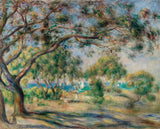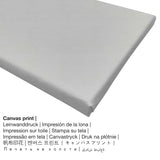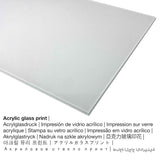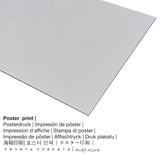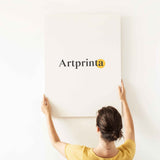Pierre-Auguste Renoir, 1892 - Bois de la Chaise (Noirmoutier) - fine art print
Tax included. Shipping calculated at checkout.
Interesting facts about this painting painted by the modern artist with the name Pierre-Auguste Renoir
This artpiece was created by the male artist Pierre-Auguste Renoir in 1892. The 120 year-old version of the artwork measures the size: Overall: 25 13/16 x 31 7/8 in (65,5 x 81 cm). Oil on canvas was applied by the painter as the medium of the work of art. Moveover, the artwork can be viewed in in the collection of Barnes Foundation. With courtesy of Courtesy of the Barnes Foundation, Merion and Philadelphia, Pennsylvania (license - public domain).: . The alignment of the digital reproduction is landscape and has a ratio of 1.2 : 1, which implies that the length is 20% longer than the width. The illustrator, painter, sculptor Pierre-Auguste Renoir was a European artist from France, whose style can be attributed primarily to Impressionism. The French painter was born in the year 1841 in Limoges, Nouvelle-Aquitaine, France and passed away at the age of 78 in the year 1919 in Cagnes-sur-Mer, Provence-Alpes-Cote d'Azur, France.
General description from the museum (© Copyright - by Barnes Foundation - www.barnesfoundation.org)
Renoir visited Noirmoutier, an island off the west coast of France to the south of Saint-Nazaire and the estuary of the river Loire, in September 1892, during an extended period touring in northwestern France. The area around the town of Noirmoutier, on the northeast comer of the island, was a select tourist destination, and especially the Bois de la Chaise, to the north of the town, which forms the subject of Renoir's canvas. The Bois was renowned for its picturesque vistas of the sea seen through the pines, and was the site of villas and chalets for the visitors, favored more, a guidebook tells us, by aristocratic than fashionable society. Renoir stayed in the island's principal hotel, the Hotel du Lion d'Or in Noirmoutier, which had an annex and a restaurant in the Bois de la Chaise. Shortly after his visit to the island, he wrote to Berthe Morisot, "I have been to Noirmoutier; it is superb and completely southern, much superior to Jersey and Guernsey, but too far away, much too far away." To Paul Gallimard, he simply commented, "Noirmoutier's a marvel."Among the significant outdoor scenes painted by Renoir between 1888 and 1893 in the Barnes Foundation, Bois de la Chaise, Noirmoutier is closest in mood and treatment to Peninsula of Saint-Jean (BF240). Tall trees frame the view, and the eye is led through smaller trees and bushes to the open sea beyond. Two fashionably dressed women sit beneath one of the background trees, and the sea is punctuated by the white sails of recreational sailing boats. This is emphatically a landscape of recreation and leisure, without the hint of agricultural labor that appears in Peninsula of Saint-Jean. As in Peninsula of Saint-Jean, the treatment of the scene is reminiscent of the later work of Jean-Baptiste-Camille Corot, especially the supple cursive branches of the foreground trees that act as a repoussoir, and the soft dappled light. Yet Bois de la Chaise, Noirmoutier is far more highly colored than Corot's later paintings; Renoir's impressionist past is evident in the play of varied colored nuances throughout the canvas. The blues in the shadows and the sea are set off against the deep reds in the tree trunks and the warm accents on the seated figure and the sunlit ground; the greens in the foliage are also constantly variegated. However, in comparison with Peninsula of Saint-Jean, there is a greater degree of schematization and simplification in the treatment of natural forms in Bois de la Chaise, Noirmoutier. The tree branches become elegant decorative patterns, and the patches of light and shade suggest sunlight falling through foliage, but wholly without closely observed detail. In his letter to Morisot, Renoir commented on the difficulty of painting landscape: "Landscape is of one's metier, but I no longer can plant myself out of doors like a street entertainer." He added, in his comments about Noirmoutier, "If I was braver, there would be some very pretty things to paint there, as there are everywhere."In light of these comments, it seems very likely that Bois de la Chaise, Noirmoutier and another very similarly treated canvas of the Bois de la Chaise were painted in the studio, perhaps after his return to Paris. This conclusion is confirmed by the striking difference between these two canvases and a third view of Noirmoutier (Museum Oskar Reinhart, Winterthur, Switzerland); this shows a similar view through trees to the sea, with a small figure, but the trees are far more specific in their forms and the whole canvas is more rapidly and informally executed. It seems very likely that this was wholly or largely executed on the spot, and that it, and perhaps other such canvases, formed the basis for the Bames's Bois de la Chaise, Noirmoutier; the reconfiguration of the scene, back in the studio, transforms it from a picture of a specific site into a more generic idyll of outdoor leisure. John House, Renoir in the Barnes Foundation (New Haven: Yale University Press, 2012), 137.
Artpiece details
| Title of the piece of art: | "Bois de la Chaise (Noirmoutier)" |
| Classification: | painting |
| Broad category: | modern art |
| Artwork century: | 19th century |
| Created in: | 1892 |
| Age of artwork: | more than 120 years old |
| Original medium of artwork: | oil on canvas |
| Original dimensions: | Overall: 25 13/16 x 31 7/8 in (65,5 x 81 cm) |
| Museum / collection: | Barnes Foundation |
| Location of the museum: | Philadelphia, Pennsylvania, United States of America |
| Website of the museum: | Barnes Foundation |
| License of artwork: | public domain |
| Courtesy of: | Courtesy of the Barnes Foundation, Merion and Philadelphia, Pennsylvania |
Artist metadata table
| Name: | Pierre-Auguste Renoir |
| Also known as: | Renoir August, Renoir Auguste, Auguste Renoir, Renoar Pjer-Ogist, רנואר אוגוסט, Renoir Pierre Auguste, a. renoir, Pierre-Auguste Renoir, Renuar Ogi︠u︡st, Renoir Pierre-Auguste, Renoir Pierre August, firmin auguste renoir, רנואר פייר אוגוסט, p.a. renoir, Renoir, August Renoir, renoir p.a., renoir a., Pierre Auguste Renoir, pierre august renoir |
| Gender: | male |
| Artist nationality: | French |
| Professions of the artist: | painter, illustrator, sculptor |
| Country of origin: | France |
| Artist classification: | modern artist |
| Art styles: | Impressionism |
| Lifetime: | 78 years |
| Born: | 1841 |
| Birthplace: | Limoges, Nouvelle-Aquitaine, France |
| Died in the year: | 1919 |
| Town of death: | Cagnes-sur-Mer, Provence-Alpes-Cote d'Azur, France |
Select your desired product material
We offer a range of different sizes and materials for every product. We allow yout to choose among the following variants:
- Aluminium dibond print: Aluminium Dibond prints are metal prints with an outstanding depth, creating a fashionable look with a surface , which is not reflective. The Aluminium Dibond Print is the best introduction to fine art reproductions with aluminum. For your Direct Aluminium Dibond print, we print the selected work of art right on the surface of the white-primed aluminum. The UV print on aluminium is the most popular entry-level product and is a truly modern way to showcase art reproductions, as it draws focus on the artwork.
- Poster (canvas material): The Artprinta poster print is a UV printed flat canvas paper with a slightly rough surface texture. Please note, that depending on the absolute size of the poster print we add a white margin of something between 2-6cm around the print, which facilitates the framing.
- Canvas print: A printed canvas material stretched on a wood stretcher frame. A canvas has a unique look of three dimensionality. Further, a printed canvas creates a soft and comfy look. How can I hang a canvas print on the wall? Canvas Prints have the advantage of being relatively low in weight, which implies that it is easy and straightforward to hang the Canvas print without the help of extra wall-mounts. Because of thatcanvas prints are suitable for any kind of wall.
- Glossy acrylic glass print: An acrylic glass print, which is often referenced as a plexiglass print, will turn your favorite original artwork into beautiful home decoration. Furthermore, it is a good alternative to dibond or canvas art prints. Your work of art is made with the help of state-of-the-art UV printing technology.
About this article
| Product type: | fine art reproduction |
| Reproduction method: | reproduction in digital format |
| Manufacturing method: | UV direct print (digital printing) |
| Production: | German production |
| Stock type: | on demand production |
| Intended usage: | home design, art collection (reproductions) |
| Image alignment: | landscape alignment |
| Image aspect ratio: | 1.2 : 1 - (length : width) |
| Side ratio implication: | the length is 20% longer than the width |
| Fabric variants: | metal print (aluminium dibond), acrylic glass print (with real glass coating), poster print (canvas paper), canvas print |
| Canvas on stretcher frame (canvas print) sizes: | 60x50cm - 24x20", 120x100cm - 47x39", 180x150cm - 71x59" |
| Acrylic glass print (with real glass coating) size options: | 60x50cm - 24x20", 120x100cm - 47x39", 180x150cm - 71x59" |
| Poster print (canvas paper) options: | 60x50cm - 24x20", 120x100cm - 47x39" |
| Aluminium print (aluminium dibond material) sizes: | 60x50cm - 24x20", 120x100cm - 47x39" |
| Art print framing: | please note that this art copy is not framed |
Legal note: We try in order to depict our art products as accurate as possible and to showcase them visually. Nevertheless, the pigments of the printing material and the print result may diverge slightly from the presentation on the monitor. Depending on the screen settings and the nature of the surface, colors might not be printed 100% realistically. Considering that our art reproductions are processed and printed manually, there might also be minor discrepancies in the motif's exact position and the size.
Copyright © - Artprinta.com

